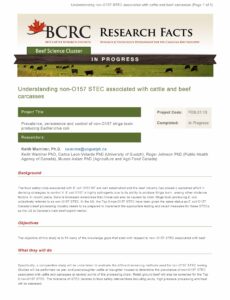Understanding Non-0157 STEC Associated with Cattle and Beef Carcasses
The food safety risks associated with E. coli O157:H7 are well established and the beef industry has placed a sustained effort in devising strategies to control it.
E. coli O157 is highly pathogenic due to its ability to produce Shiga toxin, among other virulence factors. In recent years, there is increased awareness that illness can also be caused by other Shiga toxin producing E. coli, collectively referred to as non-O157 STEC. In the U.S., the Top 6 non-O157 STEC have been given the same status as E. coli O157. Canada’s beef processing industry needs to be prepared to implement the appropriate testing and recall measures for these STECs, as the U.S. is Canada’s main beef export market.
Research currently underway and funded by the National Check-off and Canada’s Beef Science Cluster will provide an estimate of the food safety risks posed by non-O157 STEC, provide an independent assessment on the suitability of non-O157 STEC screening techniques, and verify whether current interventions applied to control E. coli O157 will also control other STECs. Canada’s beef industry will benefit from increased knowledge that will help to assure consumers about the safety of Canadian beef.
Learn More
- Understanding non-O157 STEC associated with Cattle and Beef Carcasses (BCRC Fact Sheet)
Click here to subscribe to the BCRC Blog and receive email notifications when new content is posted.
The sharing or reprinting of this BCRC Blog article is welcome and encouraged. Please provide acknowledgement to the Beef Cattle Research Council, list the website address, www.BeefResearch.ca, and let us know you chose to share the article by emailing us at info@beefresearch.ca.
We welcome your questions, comments and suggestions. Contact us directly or generate public discussion by posting your thoughts below.
